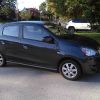Today I replaced the heater core. Why would somebody do that? If it were leaking or clogged! Clogging happens due to wrong, or mixed or unsuitable coolant or from lime scale from hard tap water (OEM method) instead of demineralized water. The deposits from just one cup of hard water can be enough. A clogged core means not much heat, usually the passenger side is affected first and more heavily than the other side.
Before you go to the trouble of replaceing it, try flushing it with strong lime scale remover first!
There are at least two different makes of aftermarket cores to choose from. I bought mine from Thermotec.
No need to remove glove box, centre console, radio, or centre vents.
On models with autotemperature there might be an actuator or something else to take off for access.
Tools needed: Just basic tools, including pliers, screwdrivers, spanners size 10 and 12, a receptable for collecting coolant, a funnel for filling coolant, a little pocket mirror to aid connecting pipes, a good portable light source, and don't forget a yoga mat to lay on for preventing bruises. It is definitely easier to do the job with the driver seat taken out. It is possible to leave it in place, but that way you will get bruised all over and look like you've been in a brawl. If you do remove the seat, do not forget the electric connector underneath.
Hardware needed: The new heater core, enough new and correct coolant. It is imperative not to mix different coolants, even if both were suitable for the car but from different makers. If it just says "for japanese" or "for Mitsubishi" it is probably the wrong stuff. Beware: The Mirage takes a different coolant than all other Mitsubishi. In Europe Glysantin G30 is good, the same stuff as for non-diesel Toyota. No idea what they sell in the States.
How to do it:
Park the car level, not on a slope. If the core was clogged, the coolant needs replacement! Put a receptable under the left side of the radiator and open the discharge screw. Then do the same under the engine discharge screw. Lift up the little container next to the radiator cap, and empty it out. Put it back. Collect old coolant for proper disposal. Fill radiator to the top with water, and flush it all out by opening both discharge screws. Repeat flushing so it comes out totally clear. Two flushings are enough. Remove the air filter box for access, three bolts size 10. Disconnect the both rubber hoses from the pipes going to the core. A pair of suitable pliers helps.
See picture:
Disconnect the minus pole of the car battery. Spanner size 10 needed.
Push driver seat all the way back. I recommend removing the driver seat for better access. but do not forget the electric connector under the seat. Lay the yoga mat on the floor where the drivers feet would be to protect you from bruises and injuries. Remove the horizontal plastic pieces under the steering wheel, including the piece above the pedals. Small philips screwdriver needed. Looking from the door, you will see the following as in the picture:
The steering ECU with its braket as seen on the top of the picture above is next. Mark the four connectors on the steering ECU so their position is is not confused. Remove the four connectors. Remove the cable clip from the bracket of the ECU. With a size 12 spanner, remove the two bolts holding the braket and set the ECU assembly aside. It looks like this:
Looking from the door with the steering ECU assembly out of the way, you can now see the heater core.
Uncrimp the two pipes from the old heater core. A small flat screw driver is helpful. Remove the pipe-clamps holding the pipes onto the plastic with a philips screw driver, and save them for later. Remove the pipes.
With the pipes out of the way, you can now pull the old core straightly all the way out.
Insert the new core all the way into its place. Install both new pipes and connect them to the core. Take care to do it 100% properly! Connecting pipes to core is the most challenging thing to do. You will be laying on your back, struggling with small parts that may fall into your face, bad view, not enough room to breath, etc. You will remember all the curses you ever heared and seemingly forgot. The pocket mirror is of help to view the rear of those wretched connections.
Reinstall the pipe-holding brackets, and check they are not appying any force to the connections.
Fill new coolant until full. Check thoroughly for leaks before doing anything further!
If no leaks are detected, reinstall the steering-ECU and its four connectors.
Reconnect the battery and start the engine. While it is warming up, keep constantly replenishing the coolant so no air pockets remain in the cooling system. When the top radiator hose becomes hot, its time to put the radiator cap on. Keep the engine in idle with the cap on until the fan comes on. There is now pressure in the cooling system so don't remove the cap. Turn off engine and recheck inside for leaks.
If there are no leaks, let the car cool off. The other parts taken off can now be put back in place.
When the car has cooled for at least half an hour, remove the radiator cap to recheck coolant level and refill the external coolant canister. Observe the fill level marks on the canister.
Expect the job to take about half a day.
Good luck! Of course, all at you very own risk.


 2014 Mitsubishi Space Star (Mirage) 1.0L
2014 Mitsubishi Space Star (Mirage) 1.0L
 Reply With Quote
Reply With Quote 2021 Mitsubishi Mirage ES
2021 Mitsubishi Mirage ES
 Shelby
Shelby Zero
Zero Zero Sen
Zero Sen


 Puttster 2
Puttster 2 My Mirage
My Mirage